Birmingham Building Stones Trails
Trail 3: Around the Shops continued
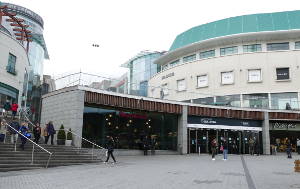
Enter the Bullring to the right of the steps
Turn back to face St. Martin’s Walk, and enter the Lower Level of the Bullring shopping centre to the right of the steps.
5. Bullring
This area of Birmingham has been a market place since Peter de Bermingham bought a licence to trade in the 12th Century. Many of us who knew Birmingham in the later half of the 20th Century will remember the Bull Ring Centre well, a functional if not beautiful architectural conglomeration. Plans were in place by the late 1990s to redevelop this area and demolition and building works began in 2000 with the mall opening three years later, reincarnated as the one-word Bullring. The mall is designed by retail specialist architects Benoy Group. Foster (2007) remarks that the new complex is ‘retail architecture at an uncomfortable moment of transition’. Nevertheless, shopping malls are always good places to see decorative polished stone, and this makes the Bullring well worth a visit. The stone contract was carried out by engineers Chapman Taylor along with Stone Cladding International, a firm well-known for supplying particularly decorative, arguably ‘glitzy’ stones, many from exotic localities. The Mall is arranged on three levels which are continuous on the Lower Level but split into two ‘wings’ on the Middle and Upper Levels by St Martin’s Walk leading down to the church of St Martin’s. Paving stones, which vary in design and stone used from level to level, are the main use of decorative stones in the Bullring.
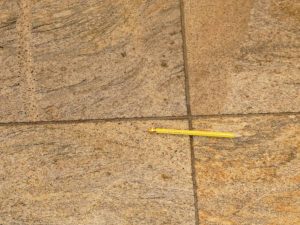
Cinza Rajado near Costa Coffee
Cinza Rajado is named by Stone Cladding International as a stone used in the Mall. This marketing name is mainly used for a Brazilian marble but it is applied here to the yellow and black striped gneiss which is used for some areas of flooring, including the area between St. Martin’s Square entrance and the junction with the main concourse (at Costa Coffee). This is almost certainly derived from Brazil and almost certainly Archaean in age but its origin is unknown. ‘Rajado’ is Portuguese for ‘brindled’ and that is certainly a good description of this stone (NB. ‘cinza’ means grey).
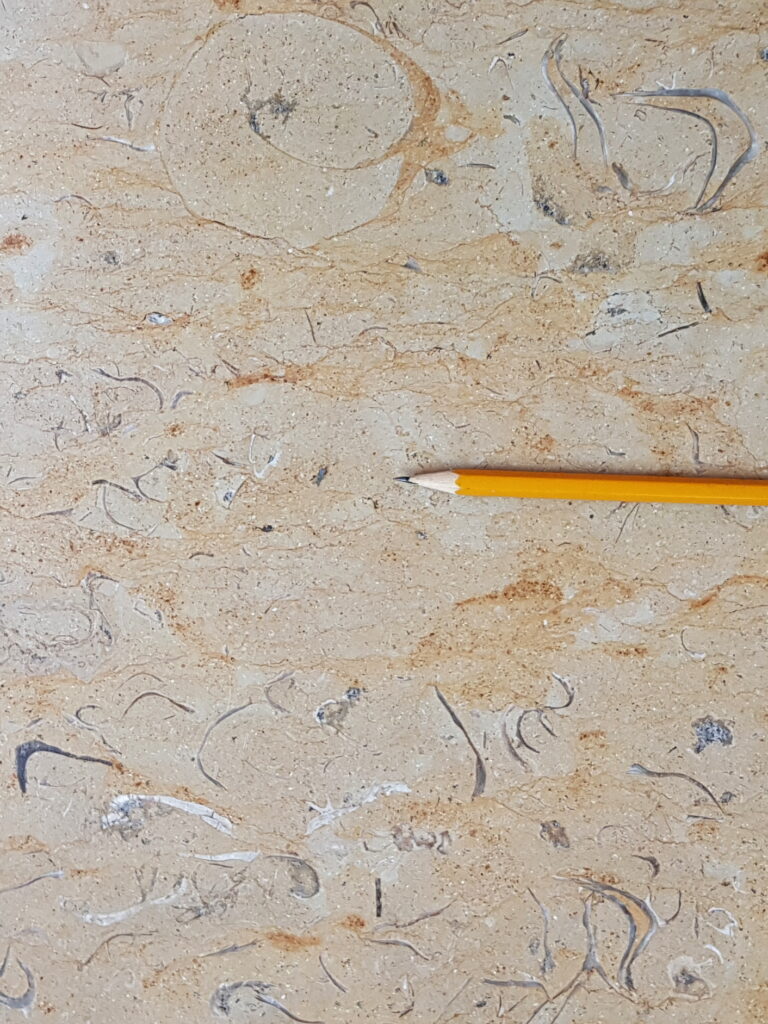
A highly fossiliferous Yana Limestone paving slab
The main paving stone used throughout the complex is a yellow-coloured Spanish, mid-Cretaceous limestone (c.125Ma). This is generally marketed as Yana Limestone which is a corruption of one of the places of origin, La Jana near Tarragona in north-eastern Spain. It is worked on a large scale from the Aptian Benassal Formation. Texturally this unit is variable in both colour and fossil content. Colour ranges from yellow through cream and even pale pink and the stone is sometimes mottled with these colours. It is variably fossiliferous, with fossils – dominantly the oyster Toucasia sp. – concentrated in shell lags. Gastropods and ammonites are also present. Some slabs are entirely devoid of fossils, others are packed full with them.
Rosso Tigrato is another metamorphic rock, this time from Brazil. It has a tiger-striped appearance, due to being composed of a finely banded pink and black gneiss with narrow injections of granite which are rotated parallel to the foliation. This stone is used in decorative paving in the mall, notably here at the roundel (stop 5b) and around the nearby escalators (stop 5c). This stone is a migmatite, a ‘Juparana’ with a granitic composition; the pink colouration being imparted by potassic feldspars and biotite as the main mafic phase. It is from the Archaean São Francisco Craton, quarried near Ruy Barbosa in Bahia State. The São Francisco Craton (c.2.5–2.0Ga) is an ancient remnant of the Earth’s continental lithosphere covering a vast area near the NE coast of Brazil, about 1000 miles north of Rio de Janeiro).

Rosso Tigrato and Vånga Granite, Lower Level
This is a very popular stone, used for cladding buildings but also for paving both internally and externally. It is extractable in large slabs and blocks, due to the outcrop having a system of widely spaced joints. Vånga is also used for the cylindrical seats on the Upper Level of the Mall and near the Lower Level exit from the Mall onto Smallbrook Queensway and the Bus Station outside Grand Central.
Retrace your steps along the concourse as far as the first flight of escalators (stop 5c).
These escalators are decoratively surrounded by Rosso Tigrato with a lozenge-shaped feature in Vånga granite between them. The escalator housing is faced with Yana Limestone, providing an opportunity to see some fossils without looking down.
Move on to the next flight of escalators, where two contrasting stones are used as paving and to face the escalator housing (stop 5d).
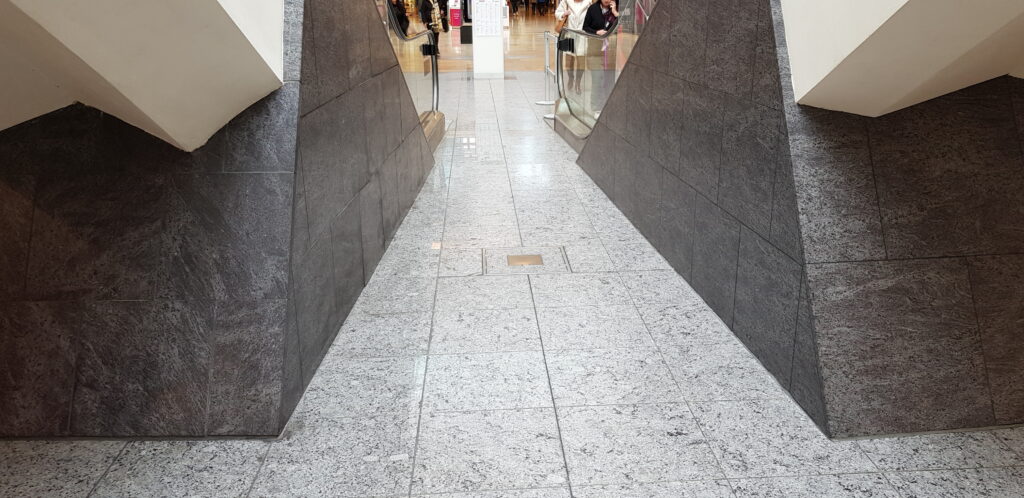
Vizag Blue and Orissa Blue, between escalators, stop 5d, Lower Level
Vizag Blue is an attractive, dark purplish-coloured metamorphic rock. It is used around the escalators here, and for decorative features on the Upper Level of the Mall. It is a garnet-bearing migmatitic gneiss (c.1.5–2.0Ga) from the Eastern Ghats Mobile Belt of north east India. It is quarried in several localities around the towns of Srikakulam, Tekkali and Patapatnam in the state of Andhra Pradesh. It is named after the local civic centre, Visakhapatnam, which is often shortened to ‘Vizag’.
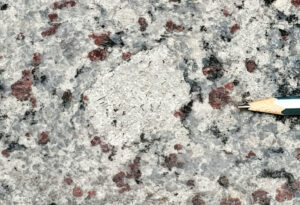
Orissa Blue, rich in red garnets
Orissa Blue is the trade name of the accompanying stone. The Eastern Ghats Mobile Belt extends northwards through Andhra Pradesh into Orissa (Odisha) State, parallel to the coast of the Bay of Bengal. Orissa Blue is paler in colour but essentially the same mineralogy (and age) as Vizag Blue. Texturally it is different and distinctive, with large, brick-shaped porphyroblasts of plagioclase aligned in the gneissose matrix. It too is very rich in red garnets.
The migmatites are part of a suite of very high grade metamorphic rocks of charnockitic composition, containing the minerals garnet, plagioclase and potassic feldspars, biotite, orthopyroxene and opalescent quartz. The Eastern Ghats Mobile Belt represents a series of deep crustal rocks accreted during multiple orogenic events during the Palaeoproterozoic, between 1.5 and 2 billion years ago. The pleasing colour of this stone and its ability to take a high polish has made it very popular as a decorative stone not only in shopping malls, but it has also become a stock material for monumental masons.
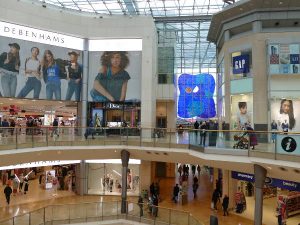
The linkway to Grand Central
Go up two flights of escalators to the Upper Mall. Turn round and head towards the end of the concourse.
The yellow fossiliferous Yana Limestone again forms the bulk of the paving, and there is continuity with the Lower Level design with further diamond-shaped features using Vizag Blue and Orissa Blue stone making attractive use of the two stones, contrasted against the Yana Limestone..
Exit the main concourse of the Bullring heading towards a conspicuous blue stained glass window.
Note that in this area there are some round stone seats clad in Vånga Granite, and some square ones clad in Orissa Blue. Both of these stones have been seen as paving earlier in this walk through the Bullring shopping centre.
Trail 3 continues on the next page…
References can be found on the last page of the walk (3.5).



